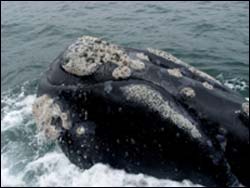
Crablike ’whale lice’ show how endangered cetaceans evolved
University of Utah biologists studied the genetics of “whale lice” – small crustaceans that are parasites on endangered “right whales” – and showed the giant whales split into three species 5 million to 6 million years ago, and that all three species probably were equally abundant before whaling reduced their numbers.
The five-year study, published in the October 2005 issue of the journal Molecular Ecology,
Scientists in Global Drifter Program deploy ceremonial 1,250th buoy
An ambitious idea spawned more than 20 years ago to develop a new way to watch the world change has come to fruition.
The Global Drifter Program (GDP), largely led by Scripps Institution of Oceanography at the University of California, San Diego, and Scripps Distinguished Professor Peter Niiler, will meet its lofty goal of blanketing the globe on Sept. 18 when the program’s 1,250th instrument is
The Swedish Defense Research Agency (FOI) and Uppsala University have shown that a method previously used to warn about mining quakes can be used to predict where and when earthquakes are going to take place.
“Using this method, major quakes like the one that caused the tsunami could be predicted better, both in terms of time and geographic area,” says Leif Persson, a researcher at FOI.
Seismology researchers at FOI and Uppsala University have retrospectively examined
DFO’s maps aid flood analysis, providing insight into river and coastal flooding due to storm surge
Researchers with the Dartmouth Flood Observatory at Dartmouth College have been working with state and federal officials, along with representatives from NGOs, to help map and analyze the flooding that has occurred as a result of Hurricane Katrina. The maps not only provide an overview of the impact and enormity of the flooding, they also preserve a day-to-day record of this
The East Pacific Rise, a vast volcanic mountain range submerged in the eastern Pacific Ocean, is one of the fastest seafloor factories on the planet. Here, along a rocky spine that runs about 1,000 miles west of South America, oceanic crust is created from magma bubbling up from deep within Earth’s interior.
Forces that shape these young oceanic plates have come into clearer focus through research conducted by scientists at the Woods Hole Oceanographic Institution, Brown Univers
An Earth System model developed by researchers at the University of Illinois at Urbana-Champaign indicates that the best location to store carbon dioxide in the deep ocean will change with climate change.
The direct injection of carbon dioxide deep into the ocean has been suggested as one method to help control rising carbon dioxide levels in the atmosphere and mitigate the effects of global warming. But, because the atmosphere interacts with the oceans, the net uptake of carbo